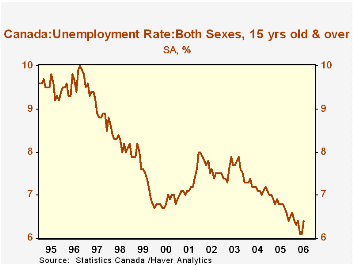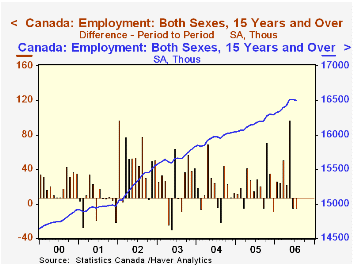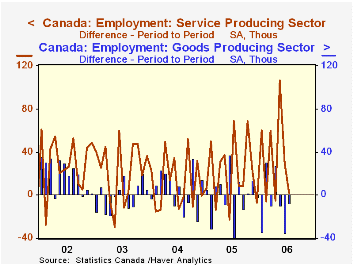 Global| Aug 04 2006
Global| Aug 04 2006Pause in Canada Labor Market Advance
Summary
We last wrote about the Canadian labor force four months ago and we extolled the 31-year low in unemployment, 6.3% in March. After an uptick in April, the rate dropped to another 31-year low of 6.1% in both May and June. But July saw [...]

We last wrote about the Canadian labor force four months ago and we extolled the 31-year low in unemployment, 6.3% in March. After an uptick in April, the rate dropped to another 31-year low of 6.1% in both May and June. But July saw it climb back to 6.4%. Part of the rise is explained by an increase in participation, particularly among women. This increase in the number of people willing to work met with a modest decrease in employment by 5,500 after a 4,600 loss in June. The resulting employment rate (employment as a % of population) fell to 63.0%, the lowest since April.
The press reports note that the fall in employment and the rise in unemployment were not expected and are therefore very dramatic. But these developments come in the wake of an extraordinary employment gain of 96,700 in May. That was the second largest monthly increase since 1976, with the largest in this span just a bit more, 97,000, in January 2002. So it is hard not to expect some pause to follow that big move. And what we have in these two latest months is minuscule, 0.03% each time, so it's more that employment stabilized rather than "falling".
In the big May rise, several industry groups participated, particularly finance and related services, health care and public administration. There were also notable gains in professional services, culture & recreation and accommodations & food services. In the subsequent months, only one, professional services, lost all of its May increase. Others grew in at least one of June or July; accommodation and food services increased in both. The total services sector grew 1.1% in the last three months and is up 2.9% over a year ago.
Goods-producing industries are not so strong, as a brief flurry in manufacturing back in the spring faded quickly. Mining and construction have stronger trends, but mining is small -- roughly 325,000 employees all together -- so 7% growth there over a year ago doesn't add many total workers. Construction has more impact, though, and it too is up more than 7% year-on-year, adding almost 72,000 workers. So there is diverse growth in Canadian employment opportunities and a two-month pause hardly indicates that these gains have stopped in their tracks.
| Canada (Seasonally Adjusted) | Jul 2006 | June 2006 | May 2006 | Year Ago | 2005 | 2004 | 2003 |
|---|---|---|---|---|---|---|---|
| Unemployment Rate (%) | 6.4 | 6.1 | 6.1 | 6.8 | 6.8 | 7.2 | 7.6 |
| Participation Rate (%) | 67.3 | 67.2 | 67.3 | 67.2 | 67.2 | 67.5 | 67.5 |
| Employment (Change, 000s/%) | -5.5 | -4.6 | +96.7 | 2.0% | 1.4% | 1.8% | 2.4% |
| Goods-Producing | -7.4 | -34.7 | -9.8 | -0.6% | 0.2% | 1.7% | 1.2% |
| Service-Producing | +1.8 | +30.2 | +106.4 | 2.9% | 2.1% | 1.8% | 2.7% |
Carol Stone, CBE
AuthorMore in Author Profile »Carol Stone, CBE came to Haver Analytics in 2003 following more than 35 years as a financial market economist at major Wall Street financial institutions, most especially Merrill Lynch and Nomura Securities. She had broad experience in analysis and forecasting of flow-of-funds accounts, the federal budget and Federal Reserve operations. At Nomura Securities, among other duties, she developed various indicator forecasting tools and edited a daily global publication produced in London and New York for readers in Tokyo. At Haver Analytics, Carol was a member of the Research Department, aiding database managers with research and documentation efforts, as well as posting commentary on select economic reports. In addition, she conducted Ways-of-the-World, a blog on economic issues for an Episcopal-Church-affiliated website, The Geranium Farm. During her career, Carol served as an officer of the Money Marketeers and the Downtown Economists Club. She had a PhD from NYU's Stern School of Business. She lived in Brooklyn, New York, and had a weekend home on Long Island.





